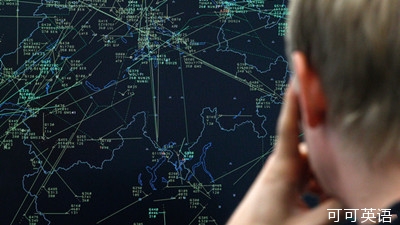科學技術
Low-cost radar
低成本雷達
A programme worth watching
值得一看的節(jié)目
How air-traffic control can use television signals to plot aircraft
空中交通管制局如何利用電視信號找出飛行器位置?
A NOVEL radar will soon be helping to keep an eye on aircraft flying over London.
很快,一種新式雷達將幫忙監(jiān)視倫敦上空的飛機。
Conventional radar uses a rotating antenna to sweep the sky, sending out radio pulses and detecting those which are reflected back from aircraft.
傳統(tǒng)雷達使用旋轉天線掃視上空,不斷發(fā)出射電脈沖并探測被飛行器反射回來的部分。
The experimental system that will begin operation in June does not send out any signals of its own,
而將于6月份啟動的實驗系統(tǒng)并不會自己發(fā)出任何信號,
 but instead relies on a network of receivers to pick up television programmes.
but instead relies on a network of receivers to pick up television programmes.
而是依靠一個接受電視信號的接收器網絡。
It is hard to imagine British TV staples like Cash in the Attic, Downton Abbey and endless repeats of Top Gear being used to detect aircraft.
很難想象像《家中藏寶》、《唐頓莊園》、《瘋狂汽車秀》等這類英國的主打電視節(jié)目被用來偵查飛行器。
But that, in effect, is what will be happening.
但事實就將會如此。
By measuring the slight differences between the original broadcast signal and the signals reflected from aircraft flying in the vicinity, it is possible to plot the position of aircraft on a screen, just as is done with conventional radar.
通過測量原廣播信號和附近飛行器反射信號間的細微差別,有可能在屏幕上標繪出飛行器的位置,這和傳統(tǒng)雷達的工作原理一樣。
The difference is that a system that relies on signals already in the air can be simpler, cheaper and use a lot less power.
兩者的區(qū)別是,利用空中已有信號的操作系統(tǒng)可以更簡便、更便宜,還能省不少電。
The London trial is being run by Thales UK, an engineering group, Roke Manor Research, an RD consultancy, and NATS, which manages Britain's air-traffic control.
倫敦實驗系統(tǒng)的運行由工程組泰利斯英國公司、研發(fā)咨詢公司曼樂研究公司和英國國家空運局負責,
It is backed by the British government's Technology Strategy Board.
并得到了英國政府技術戰(zhàn)略委員會的支持。
The group call their system multi-static primary surveillance radar.
工程組把自己的系統(tǒng)稱為多基站主監(jiān)視雷達,
It is a form of passive radar, which goes back a long time.
屬于存在已久的被動雷達中的一種。
Although it had been known since the late 19th century that radio waves can be reflected by objects, it was not until the years leading up to the second world war that a number of countries began secretly developing ways to detect aircraft.
雖然19末世紀時人們就已經知道物體能夠反射無線電波,但直到二戰(zhàn)前幾年才有一些國家開始秘密研究偵查飛機的方法。
Many of the early tests relied on ordinary broadcasts to provide the signals.
這些早期的測試當中有很多都靠普通的無線電波來提供信號。
In an experiment in 1935 a Handley Page Heyford bomber flew between a receiving station and a BBC transmission tower to see how well it could be detected.
在1935年的一場實驗當中,一個名為亨得利·佩奇·海福德飛行員駕駛轟炸機從BBC發(fā)射塔和一個接收站之間飛過,從而找出飛機能在多大程度上被偵查出來。
Well enough, it seems, because the Air Ministry immediately ordered a full demonstration system.
看來當時的效果還不錯,因為航空部馬上下達命令要求進行全套演示。
Blip, blip
雷達界的新老交替
In 1940 the US Navy coined the term radar to describe radio detection and ranging.
1940年,美國海軍創(chuàng)造出雷達一詞,用以描述無線電探測和測距。
Modern radar is highly sophisticated but it largely relies on emitting a signal.
現代雷達極其復雜,但主要還是靠自己發(fā)出信號。
By measuring the time taken for the reflected signal to return it is possible to work out the position of an aircraft.
通過測量被反射信號返回雷達所需的時間,就有可能計算出飛行器的位置。
A slight shift in the frequency, because of the Doppler effect, means its speed and direction can be measured too.
由于多普勒效應,返回信號的頻率有微小變化,這就意味著飛行器的速度和飛行方向也可以被測量出來。
Passive radar can take similar measurements and is already used in limited ways, mostly by the armed forces.
被動雷達可以進行類似的測量,并且已經得到一些受限應用。
Relying on background signals to detect objects has an advantage in stealth operations:
在秘密行動中依靠背景信號來偵查物體有這樣一個優(yōu)勢:
no pulse is sent out to alert anyone to what you are doing, or attract an anti-radar missile.
由于沒有發(fā)出脈沖信號,沒人會警覺你在什么,也不會引來反雷達導彈。
The growth in radio and television broadcasts—especially with digital and high-definition TV—now provides an enormous amount of high-frequency radio waves which are ideally suitable for passive radar systems.
現在無線電和電視廣播的增長提供了海量的高頻電波,這些非常適合用于被動雷達系統(tǒng)。
Moreover, the availability of cheap and powerful computing makes it feasible to analyse the data required to build a system like MSPSR.
此外,成本低廉和功能強大的計算機可以分析需要用于建立類似MSPSR系統(tǒng)的數據。
Thales and its partners expect to be able to produce results as good as conventional radar.
泰利斯工程組和合伙人們期待MSPSR的表現能和傳統(tǒng)雷達一樣好。
The trials are designed to see how passive radar could support Britain's air-traffic management.
實驗項目的目的在于找出被動雷達能夠如何幫助管理英國的空中交通。
It could help small airports that lack radar or fill gaps in areas where coverage is currently patchy.
它有助于那些缺乏雷達的小型機場,或者彌補那些雷達覆蓋不完整地區(qū)的缺陷,
MSPSR might also reduce the interference caused in some places by wind turbines.
MSPSR還能減少一些地方由渦輪機造成的干擾,
And because it is a networked system it could be more reliable than the present set-up, which typically depends on using just one radar at each airport.
它是一個呈網絡覆蓋的系統(tǒng),比目前的系統(tǒng)更可靠。
The aviation industry is cautious about adopting new technologies wholesale, so there is a long way to go before conventional radar is turned off in favour of passive systems.
航空業(yè)在大規(guī)模采用新技術方面很是謹慎,因此傳統(tǒng)雷達完全讓位于被動雷達還尚有時日。
But governments may be tempted to think about doing so, for reasons that go beyond passive radar's lower operating costs.
但政府或許會對此動心,原因不只是被動雷達的成本更加低廉:
With growing demand for wireless devices, passive radar would allow the radio spectrum currently used by conventional radar to be freed up and auctioned off to mobile operators.
隨著無線設備的需求不斷增加,被動雷達能夠將目前用于傳統(tǒng)雷達的無線電頻譜解放出來,然后再拍賣給移動運營商。
One difficulty is that passive radar relies on a third party for its signals.
被動雷達的一個難題在于它要依靠第三方提供的信號。
The continued availability of transmissions is considered to be part of Britain's critical national infrastructure, says John Smith, the project leader for Thales.
泰利斯工程組的項目帶頭人約翰?史密斯說,廣播電視業(yè)被認為是英國關鍵的國家基礎設施。
Nevertheless, he adds, the study will look at how agreements can be made with broadcasters to ensure reliability and performance, and how to deal with routine maintenance when TV transmission towers are turned off.
不過他補充道,研究將著眼于如何跟廣播公司達成協(xié)議,以及如何在電視信號發(fā)射中斷時進行例行維護。
Air-traffic controllers and pilots would not take kindly to being confronted with the equivalent of a TV test card.
空中交通管制員和飛行員可不會樂意接受電視測試卡的等價物。
 but instead relies on a network of receivers to pick up television programmes.
but instead relies on a network of receivers to pick up television programmes.
 but instead relies on a network of receivers to pick up television programmes.
but instead relies on a network of receivers to pick up television programmes.